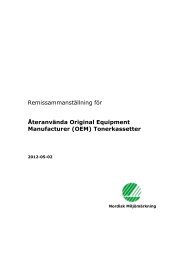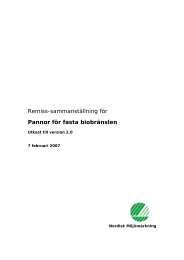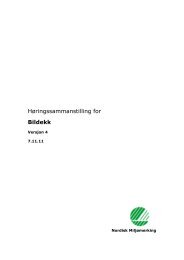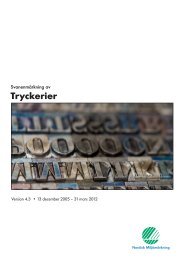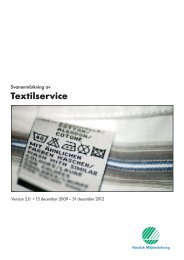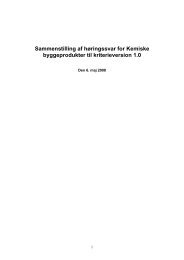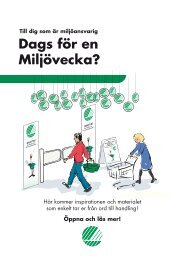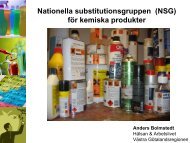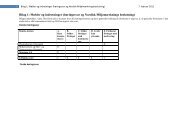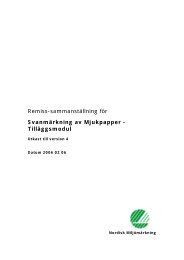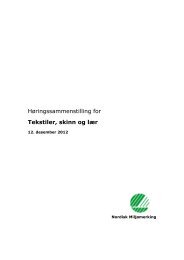Småhus, flerbostadshus och förskolebyggnader - Svanen
Småhus, flerbostadshus och förskolebyggnader - Svanen
Småhus, flerbostadshus och förskolebyggnader - Svanen
Create successful ePaper yourself
Turn your PDF publications into a flip-book with our unique Google optimized e-Paper software.
Nordisk Miljømerking<br />
Hus, leiligheter og barnehager 089/versjon 2<br />
Høringssammenstilling, oppdatert 10. august 2010<br />
7.3. Bilag C European Aluminium Association AISBL: Life<br />
Cycle Management<br />
Declaration by the Metals Industry on Recycling Principles<br />
DOI: http://dx.doi.org/10.1065/lca2006.11.283<br />
The metals industry works towards the establishment of an accurate understanding of<br />
metals recycling. Environmental models and policy discussions that concern product<br />
recycling should characterize material recycling in a manner that is appropriate and that<br />
promotes the objectives of sustainable development.<br />
Objectives<br />
To this end, the metals industry supports the characterization and modeling of recycling<br />
of metal-containing products in a way that:<br />
1. Encourages good environmental practices;<br />
2. Aids assessment of the overall life cycle of products and understanding of materials;<br />
3. Supports the management of the life cycle of products and stewardship of materials;<br />
4. Is consistent with scientific knowledge and technical practices; and<br />
5. Reflects economic realities without creating market distortions that impede<br />
environmental objectives.<br />
About metal recycling<br />
Metals are highly recyclable and in fact a large percentage of metallic material is<br />
effectively recycled. Collected metal scrap is converted to new material of equal or<br />
similar quality through metallurgical processes, including remelting and refining. Some<br />
products require metal grades that demand minimal processing; other products may<br />
require more metallurgical and process controls to meet specifications. Metal<br />
inputs for metal production are principally sourced via the most cost effective route,<br />
whether this is from primary ores or from recycling of recovered metal resources. The<br />
source of the metal however, whether primary or from recycling, can not be determined<br />
by material properties. Therefore, scrap that is sorted and clean commands a higher<br />
market price owing to the ease of subsequent processing through recycling. The final<br />
economic value of the metal product is determined by its utility for applications and its<br />
recycled content may be high or low, depending, amongst other aspects, on the<br />
availability of secondary material at the time of manufacture.<br />
Metal scrap that is collected for recycling is material that does not have to be managed as<br />
a waste. It is a valuable resource that is converted into value-added commodities.<br />
Perhaps even more importantly, recycled metal substitutes or displaces the necessity to<br />
mine new metal. Consequently, metal recycling offsets primary production processes<br />
− and their associated environmental impacts and energy consumption − required to dig,<br />
crush, grind and otherwise metallurgically process virgin ore. Recycling increases the<br />
material and energy efficiency of product systems throughout the life cycle and thus is<br />
good management practice.<br />
Facts The following are relevant to metals recycling:<br />
159 (165)



